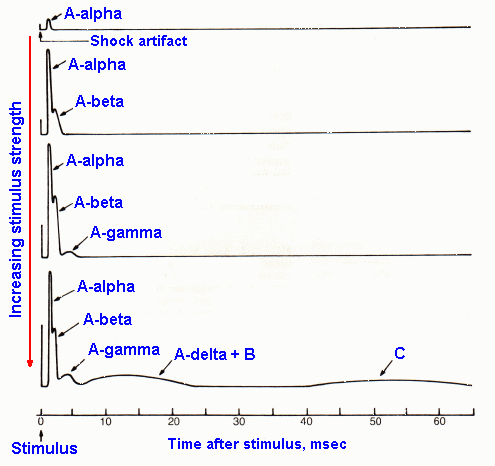Large diameter axons conduct action potentials faster than smaller ones, and the process is speeded up further by the presence of myelin.
When electrical stimuli are applied (in A), subthreshold voltages do not elicit an action potential, but as the stimulus strength is increase, it is possible to record action potentials further down the nerve.
The conduction velocity can be calculated knowing the distance between stimulating and recording electrodes, and the time taken for conduction along the axons.
As the stimulus is increased all the largest fibres in the nerve are activated and cause a large peak of potential caused by the action potentials in all the fastest axons. This peak is known as the A-alpha wave.
|
|
|
The top trace in the diagram opposite shows the A-alpha only peak over a longer time course.
The stimulus necessary to initiate an action potential in small axons is larger than for larger diameter axons.
As the stimulus is increased, smaller axons begin to generate their action potential, and these potentials are more slowly. Examples are the A-beta, A-gamma and A-delta potentials; it takes more time for the action potentials of smaller axons to arrive at the recording site.
All of the A waves are due to action potentials in myelinated axons: A alpha axons have a lot lf myelin, whereas A-delta axons are finely myelinated.
Finally at very high stimulus strengths the unmyelinated C-fibres are activated, and it can be seen that the conduct very slowly.
Conduction Velocity
Axons conduct APs at different velocities, and the fastest use a process called Saltatory Conduction.
Large myelinated axons conduct rapidly (100+ m/sec).
The high speed is due largely to the myelin:
the AP jumps from one node of Ranvier to the next because currents follow pathways of least resistance, and myelin (rolled fatty cell membrane) has a high resistance
A fibres conduct at high speed
A-alpha conducts more rapidly than A-beta and A-delta (because of the lower degree of myelination of the slower conducting axons). See Saltatory Conduction (below).
C fibres are unmyelinated and conduct very slowly (1 m/s) |
 * *
The thresholds of large axons are lower than the thresholds of small diameter axons. The diagram shows the effects of increasing stimulus strength, as a result of which more and more small axons become active. Smaller axons conduct more slowly and this is the basis of identifying A-beta (large myelinated), A-gamma and A-delta fibres (finely myelinated), and C (unmyelinated) axons.
For mammalian myelinated axons the conduction velocity (m/sec) is approximated 6x the diameter of the axon. |